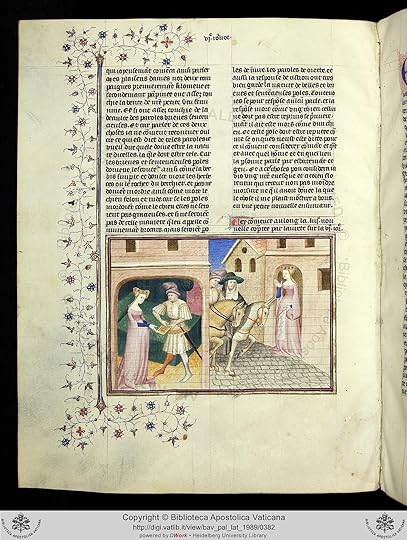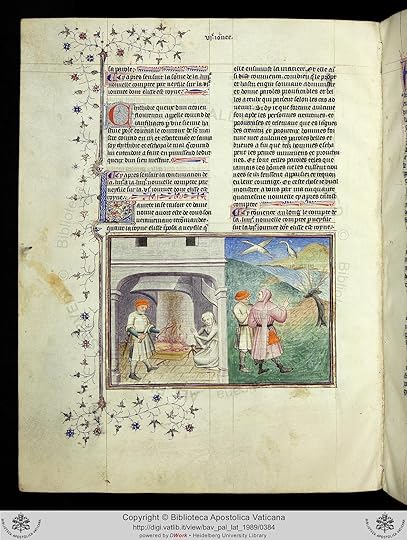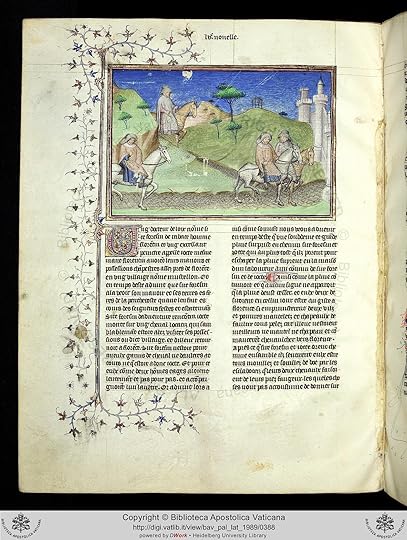Divine Comedy + Decameron discussion

This topic is about
The Decameron
Boccaccio's Decameron
>
8/11-8/17: Sixth Day, Introduction & Stories 1-5
date newest »
newest »
 newest »
newest »
message 1:
by
Kris
(new)
-
added it
Apr 14, 2014 09:37AM
 Mod
Mod
reply
|
flag
 Illustrations - Day VI Story 1
Illustrations - Day VI Story 1
http://gallica.bnf.fr/ark:/12148/btv1...
Lauretta sur le cheval

Source: gallica.bnf.fr
(view spoiler)
 Illustrations - Day VI Story 2
Illustrations - Day VI Story 2
http://gallica.bnf.fr/ark:/12148/btv1...
Le boulanger Cisti devant son four

Source: gallica.bnf.fr
(view spoiler)
 Illustrations - Day VI Story 3
Illustrations - Day VI Story 3
http://gallica.bnf.fr/ark:/12148/btv1...
Diego de la Rath & Nonna
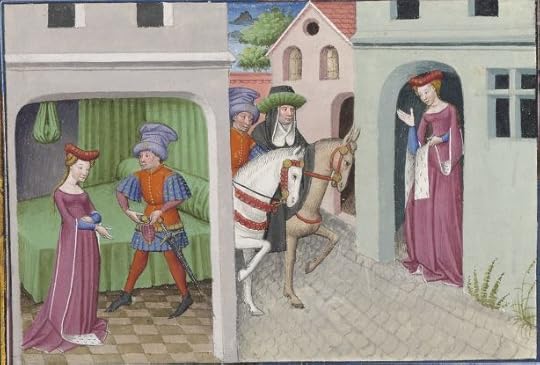
Source: gallica.bnf.fr
(view spoiler)
 Illustrations - Day VI Story 4
Illustrations - Day VI Story 4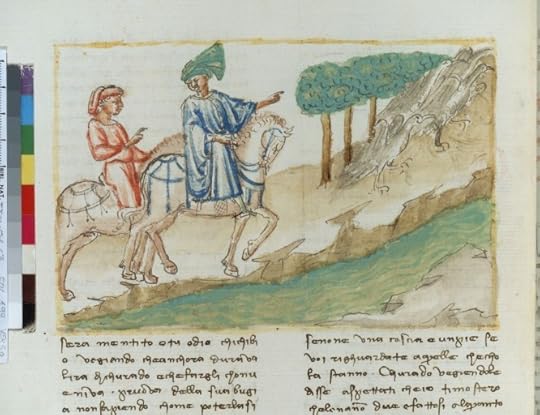
http://gallica.bnf.fr/ark:/12148/btv1...
Chichibio, Currado & les grues

Source: gallica.bnf.fr
(view spoiler)
 Illustrations - Day VI Story 5
Illustrations - Day VI Story 5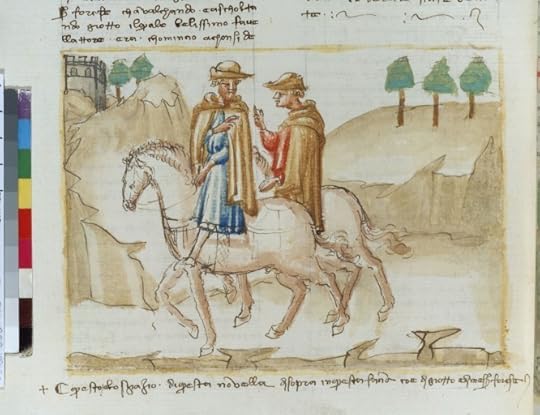
http://gallica.bnf.fr/ark:/12148/btv1...
Forese da Rabatta & Giotto chevauchant
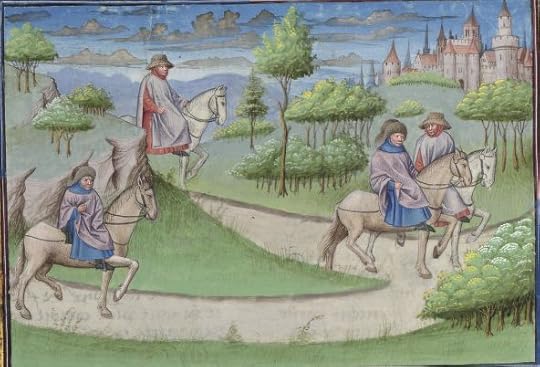
Source: gallica.bnf.fr
(view spoiler)
Toto wrote: "Once again, fun pictures, Book Portrait.
But these pictures can't quite capture this week's theme, quick wit and how it can get you out of trouble. Witty repartees are so pleasant both for the p..."
Yes, I also made note of:
Lovesome ladies, there is much truth in what both Pampinea and Filomena have been saying about the beauty of repartee and our own lack of skill in its use. It is unnecessary to repeat their arguments, but I should like to remind you that apart from what has already been said on this subject, the nature of wit is such that its bite must be like that of a sheep rather than a dog, for if it were to bite the listener like a dog, it would no longer be wit but abuse.
It is of course true, in the case of repartee, that when someone bites like a dog after having, so to speak, been bitten by a dog in the first place, his reaction does not seem as reprehensible as it would have been had he not been provoked and one therefore has to be careful over how,when, on whom, and likewise where one exercises one’s wit. ( The Decameron, Sixth Day, Third Story)
But these pictures can't quite capture this week's theme, quick wit and how it can get you out of trouble. Witty repartees are so pleasant both for the p..."
Yes, I also made note of:
Lovesome ladies, there is much truth in what both Pampinea and Filomena have been saying about the beauty of repartee and our own lack of skill in its use. It is unnecessary to repeat their arguments, but I should like to remind you that apart from what has already been said on this subject, the nature of wit is such that its bite must be like that of a sheep rather than a dog, for if it were to bite the listener like a dog, it would no longer be wit but abuse.
It is of course true, in the case of repartee, that when someone bites like a dog after having, so to speak, been bitten by a dog in the first place, his reaction does not seem as reprehensible as it would have been had he not been provoked and one therefore has to be careful over how,when, on whom, and likewise where one exercises one’s wit. ( The Decameron, Sixth Day, Third Story)
 Hurrah! I've caught up with the schedule! Loved the story about the crane, actually I thought all this group were still funny despite the passage of time
Hurrah! I've caught up with the schedule! Loved the story about the crane, actually I thought all this group were still funny despite the passage of time
 Jan-Maat wrote: "Hurrah! I've caught up with the schedule!"
Jan-Maat wrote: "Hurrah! I've caught up with the schedule!"Yay! Well done. I'm sorta caught up, minus day III and a couple of stories in Day II. ^^
This week's stories were really short - I wonder what happened to Boccaccio to explain that. I enjoyed Nonna's comeback in the third story and loved the crane story with its delicious touch of nonsense that blindsides reason. :)
On reading the Decameron, historians of art are often struck by one particular fact: no less than six of Boccaccio's hundred tales center upon painters who also figure in the history of art. Of these the most famous is Giotto who appears on the sixth of the Decameron's ten days of story telling.
http://www.jstor.org/discover/10.2307...
http://www.jstor.org/discover/10.2307...
A star is born
Seven centuries ago, Giotto was famous for being famous. Jonathan Jones pays tribute to the world's first celebrity artist
http://www.theguardian.com/artanddesi...
Seven centuries ago, Giotto was famous for being famous. Jonathan Jones pays tribute to the world's first celebrity artist
http://www.theguardian.com/artanddesi...
Did any of you mention reading this book:
http://www.amazon.com/Visualizing-Boc...
Have a look inside....
http://www.amazon.com/Visualizing-Boc...
Have a look inside....
Giotto di Bondone (c. 1267 - 1337): Decameron VI.5
Throughout the centuries, Giotto di Bondone has been recognized as one of the most important innovators of European painting, and as the first of the great Italian masters. His style broke with convention in many ways. In contrast to the splendid but impersonal art of Byzantium that had held sway for centuries, Giotto's was spare, dramatic, and focused on human emotion. Giotto's new style laid the foundation upon which the future progress of Renaissance art was based.
Born a few miles north of Florence, probably to a family of small means, Giotto studied under Cimabue, a painter whose style also surpassed that of his peers at the time. Since there is little documented evidence concerning Giotto's life and production, it is difficult to positively identify works attributable to him or to attempt dating with any certainty. It is conjectured, though the issue is still hotly debated, that the frescos of the upper church of St. Francis of Assisi were done at least partly by Giotto's hand sometime before 1300. Around the turn of the century, when Giotto was known to be in Rome, he executed a mosaic over the entrance to St. Peter's (the navicella), but travelled on to Padua at some point between 1305 and 1309, where he worked on the fresco cycle of the Arena (or Scrovegni) Chapel. There is evidence that after this point, around 1311 to 1314, Giotto moved to Florence; four chapels within the Church of Santa Croce contained frescoes apparently created by his hand. These frescoes, unfortunately, have all been severely damaged or completely lost. From 1330-1333, as a guest at the royal court of Naples, Giotto completed numerous projects which have not been preserved. Upon his return to Florence in 1333, Giotto was appointed surveyor of the Duomo and chief architect of Florence, a position that reflected the great esteem in which he was held by his fellow citizens. Giotto di Bondonedied in 1337.
Giotto, referred to as the "miglior dipintore del mondo" is the protagonist of the fifth tale of Day Six.
Throughout the centuries, Giotto di Bondone has been recognized as one of the most important innovators of European painting, and as the first of the great Italian masters. His style broke with convention in many ways. In contrast to the splendid but impersonal art of Byzantium that had held sway for centuries, Giotto's was spare, dramatic, and focused on human emotion. Giotto's new style laid the foundation upon which the future progress of Renaissance art was based.
Born a few miles north of Florence, probably to a family of small means, Giotto studied under Cimabue, a painter whose style also surpassed that of his peers at the time. Since there is little documented evidence concerning Giotto's life and production, it is difficult to positively identify works attributable to him or to attempt dating with any certainty. It is conjectured, though the issue is still hotly debated, that the frescos of the upper church of St. Francis of Assisi were done at least partly by Giotto's hand sometime before 1300. Around the turn of the century, when Giotto was known to be in Rome, he executed a mosaic over the entrance to St. Peter's (the navicella), but travelled on to Padua at some point between 1305 and 1309, where he worked on the fresco cycle of the Arena (or Scrovegni) Chapel. There is evidence that after this point, around 1311 to 1314, Giotto moved to Florence; four chapels within the Church of Santa Croce contained frescoes apparently created by his hand. These frescoes, unfortunately, have all been severely damaged or completely lost. From 1330-1333, as a guest at the royal court of Naples, Giotto completed numerous projects which have not been preserved. Upon his return to Florence in 1333, Giotto was appointed surveyor of the Duomo and chief architect of Florence, a position that reflected the great esteem in which he was held by his fellow citizens. Giotto di Bondonedied in 1337.
Giotto, referred to as the "miglior dipintore del mondo" is the protagonist of the fifth tale of Day Six.
Jan-Maat wrote: "Hurrah! I've caught up with the schedule! Loved the story about the crane, actually I thought all this group were still funny despite the passage of time"
Congratulations and good to see you... I had noticed in the General feed that you were reading the Decameron but I thought it was just a coincidence.
Congratulations and good to see you... I had noticed in the General feed that you were reading the Decameron but I thought it was just a coincidence.
ReemK10 (Paper Pills) wrote: "
Have a look inside...."
Thank you, Reem. It has come to my attention, but luckily we can look inside and IMO it has left so much out... It does not seem to deal with the Preraphaelites and jumps to Pasolini leaving a lot out. A shame.
Have a look inside...."
Thank you, Reem. It has come to my attention, but luckily we can look inside and IMO it has left so much out... It does not seem to deal with the Preraphaelites and jumps to Pasolini leaving a lot out. A shame.



